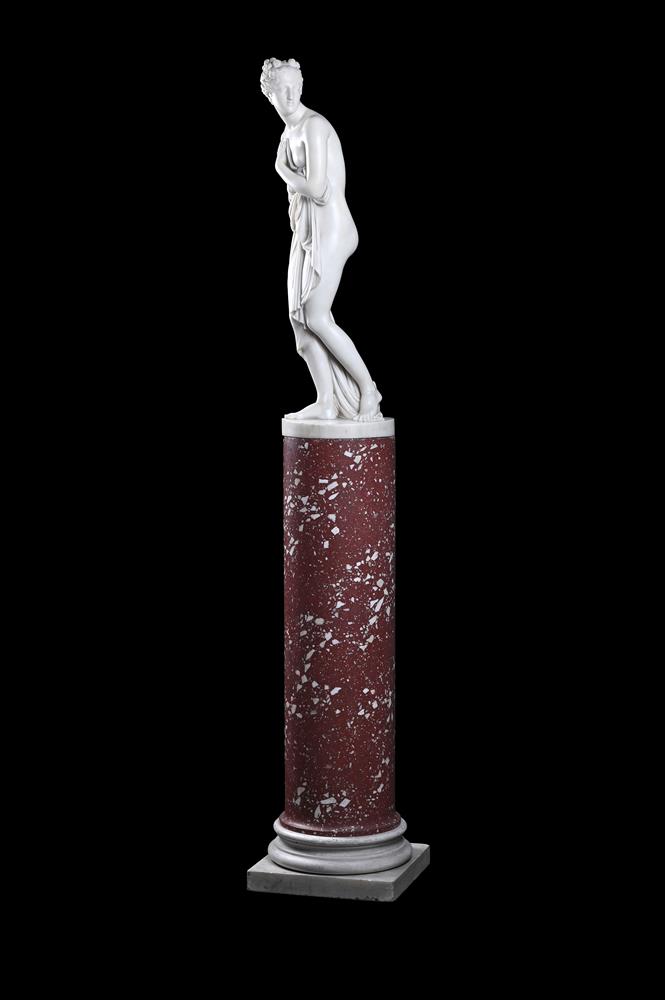AFTER CANOVA, A WHITE MARBLE FIGURE OF VENUS ITALICA PROBABLY ITALIAN, 19TH CENTURY Her left arm across her body, her right holding drapery with casket at her feet on shaped circular base 101cm high On a red scagliola column pedestal, 124cm high 225cm high overall Provenance: Nidd Hall, acquired by Guy Reed from Richard Butler 17th Viscount Mountgarret, in 1968 The Guy Reed Will Trust, Copgrove Hall, Yorkshire In 1802, Antonio Canova was asked if he would fashion a copy of the Medici Venus which Napoleon had removed from Florence to the Musée Napoléon in Paris. Although he agreed to make a copy, the sculpture that he eventually completed in 1811 was quite different from the Medici Venus. It shows a more modest figure, who largely covers her nakedness with a large swag of drapery and lacks the dolphin and the figure of Cupid that accompany the Medici Venus. Canova produced various versions of this figure: the original now in the Palatine Gallery of The Pitti Palace another in the Residenzmuseum in Munich, and the third in Hearst Castle, San Simeon, California, (formerly in the Lansdowne Collection). A fourth version was sold from the Londonderry collection in 1962 and is today in the Metropolitan Museum of Art, New York. In 1820 he also completed a version for Thomas Hope (1769-1831). This version, which Canova in fact liked best of all those he had made, was rather closer in appearance than the others to the Venus de'Medici. It is now in Leeds City Art Galleries.
AFTER CANOVA, A WHITE MARBLE FIGURE OF VENUS ITALICA PROBABLY ITALIAN, 19TH CENTURY Her left arm across her body, her right holding drapery with casket at her feet on shaped circular base 101cm high On a red scagliola column pedestal, 124cm high 225cm high overall Provenance: Nidd Hall, acquired by Guy Reed from Richard Butler 17th Viscount Mountgarret, in 1968 The Guy Reed Will Trust, Copgrove Hall, Yorkshire In 1802, Antonio Canova was asked if he would fashion a copy of the Medici Venus which Napoleon had removed from Florence to the Musée Napoléon in Paris. Although he agreed to make a copy, the sculpture that he eventually completed in 1811 was quite different from the Medici Venus. It shows a more modest figure, who largely covers her nakedness with a large swag of drapery and lacks the dolphin and the figure of Cupid that accompany the Medici Venus. Canova produced various versions of this figure: the original now in the Palatine Gallery of The Pitti Palace another in the Residenzmuseum in Munich, and the third in Hearst Castle, San Simeon, California, (formerly in the Lansdowne Collection). A fourth version was sold from the Londonderry collection in 1962 and is today in the Metropolitan Museum of Art, New York. In 1820 he also completed a version for Thomas Hope (1769-1831). This version, which Canova in fact liked best of all those he had made, was rather closer in appearance than the others to the Venus de'Medici. It is now in Leeds City Art Galleries.















Testen Sie LotSearch und seine Premium-Features 7 Tage - ohne Kosten!
Lassen Sie sich automatisch über neue Objekte in kommenden Auktionen benachrichtigen.
Suchauftrag anlegen